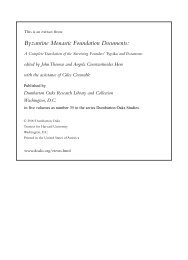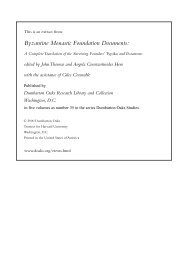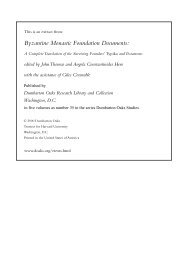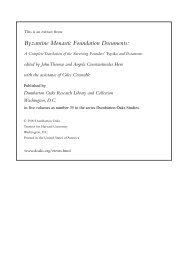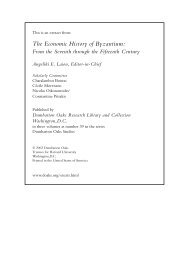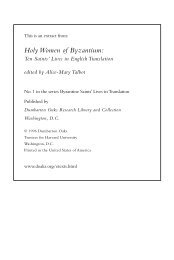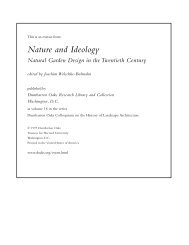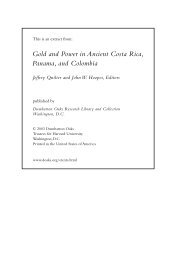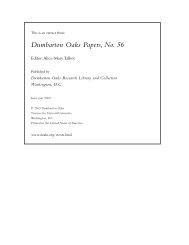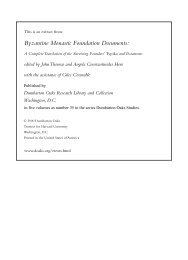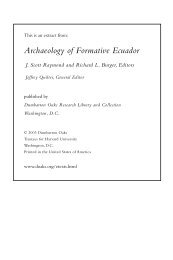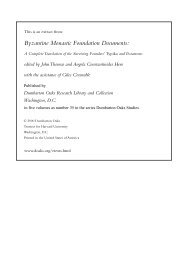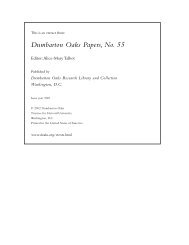Changing Economic Patterns in Latin Romania - Dumbarton Oaks
Changing Economic Patterns in Latin Romania - Dumbarton Oaks
Changing Economic Patterns in Latin Romania - Dumbarton Oaks
You also want an ePaper? Increase the reach of your titles
YUMPU automatically turns print PDFs into web optimized ePapers that Google loves.
David Jacoby [227]<br />
its consul <strong>in</strong> Thebes, the major center of silk manufacture <strong>in</strong> Lat<strong>in</strong> <strong>Romania</strong>. Some time<br />
earlier Genoese entrepreneurs had begun to f<strong>in</strong>ance production <strong>in</strong> a number of this city’s<br />
silk workshops, ordered textiles from others, and exported local fabrics. It follows that<br />
the <strong>in</strong>fusion of cash <strong>in</strong>to the economy of Lat<strong>in</strong> <strong>Romania</strong> and the function of credit were<br />
not restricted to the rural sector or to trade, and also affected <strong>in</strong>dustrial production.<br />
However, by the late thirteenth century Genoese trade <strong>in</strong> Lat<strong>in</strong> <strong>Romania</strong> appears to have<br />
been on the decl<strong>in</strong>e as a result of several developments. The cont<strong>in</strong>uous growth of highgrade<br />
silk manufacture <strong>in</strong> Lucca, as well as large-scale Genoese imports of eastern textiles<br />
and of high-grade silk from the countries around the Black Sea and the Caspian Sea<br />
offered advantageous alternatives to the products of Lat<strong>in</strong> <strong>Romania</strong>. 184 In this region the<br />
Genoese also faced what appears to have been aggressive Venetian competition, backed<br />
by the Commune.<br />
Pisans also traded <strong>in</strong> Lat<strong>in</strong> <strong>Romania</strong>. They are attested <strong>in</strong> Frankish Morea from the<br />
1270s, yet appear to have been active there earlier. In 1273 K<strong>in</strong>g Charles I of Sicily asked<br />
the Moreot pr<strong>in</strong>ce William II to dispense justice to a Pisan citizen hav<strong>in</strong>g a claim aga<strong>in</strong>st<br />
one Scottus, apparently an Italian banker. The attention paid by the Pisan trade manual<br />
of 1278 to the silk standard of Lucca used <strong>in</strong> the Morea implies that Pisans too were<br />
<strong>in</strong>volved <strong>in</strong> the export of this commodity to Lucca and other Italian manufacturers,<br />
though presumably on a much smaller scale than the Genoese. Pisans are mentioned <strong>in</strong><br />
Chiarenza <strong>in</strong> 1303, 1307, and 1313, some of them be<strong>in</strong>g apparently settled <strong>in</strong> that city.<br />
The Pisan trade manual compares the measures for gra<strong>in</strong> used <strong>in</strong> Negroponte and Pisa,<br />
which h<strong>in</strong>ts at Pisan trade <strong>in</strong> the island. No later evidence has surfaced until now, yet the<br />
cont<strong>in</strong>uation of Pisan trade <strong>in</strong> Byzantium <strong>in</strong> the Palaiologan period suggests that some<br />
activity must also have taken place <strong>in</strong> the ports of call of Lat<strong>in</strong> <strong>Romania</strong> located along<br />
the maritime routes l<strong>in</strong>k<strong>in</strong>g Pisa with Constant<strong>in</strong>ople. 185<br />
The Venetians were familiar with the territories of Lat<strong>in</strong> <strong>Romania</strong> ruled by feudal<br />
lords, <strong>in</strong> which they had traded before the Fourth Crusade. As early as 1209 Venice<br />
obta<strong>in</strong>ed full tax exemptions for its merchants, confirmed subsequently, from the lord of<br />
Frankish Morea and those of Euboea. 186 Coron, Modon, and the Venetian quarter of<br />
Negroponte depended heavily on the flow of products from their respective h<strong>in</strong>terlands,<br />
ruled by these lords. This expla<strong>in</strong>s why Venetian Coron and Frankish Chiarenza used<br />
the same light pound for the weigh<strong>in</strong>g of silk and kermes. 187 Around 1290 silk and<br />
kermes were arriv<strong>in</strong>g <strong>in</strong> Coron from both Venetian and Frankish territory, and this must<br />
have been customary for some time already. 188 It is not clear to what extent tax exemptions<br />
promoted Venetian penetration <strong>in</strong>land. Among the products handled, a few<br />
deserve particular attention. S<strong>in</strong>ce none of the Venetian colonies of Lat<strong>in</strong> <strong>Romania</strong> pro-<br />
184 See Jacoby, “Migration,” 118–20, and above, note 175. It is likely that Venetian merchants too acted as<br />
entrepreneurs <strong>in</strong> Thebes: see below, note 190.<br />
185 For Lat<strong>in</strong> <strong>Romania</strong>: Filangieri et al., I registri della cancelleria angio<strong>in</strong>a 10:93, no. 373, and Jacoby, “Migration,”<br />
112; above, note 181; R. Predelli, ed., I libri commemoriali della repubblica di Venezia: Regesti (1293–1787)<br />
(Venice, 1876–1914), 1:26, 80–81, lib. 1, nos. 108, 339, 344; above, note 178; Lopez and Airaldi, “Manuale,”<br />
127, fol. 360, l<strong>in</strong>e 10. For Byzantium: Otten-Froux <strong>in</strong> Balard, Laiou, and Otten-Froux, Italiens (as <strong>in</strong> note<br />
178), 159 and n. 36, and documents <strong>in</strong> ibid., 168–91, nos. 3, 9, 11, 12, 16.<br />
186 TTh, 2:91, 94, 97, 176, 181, and 3:55.<br />
187 See Jacoby, “Silk Production,” 55 n. 52.<br />
188 For this period and later, see Jacoby, “Silk Production,” 41, 43–47, 55–56, 60–61. See also above, p. 216.




